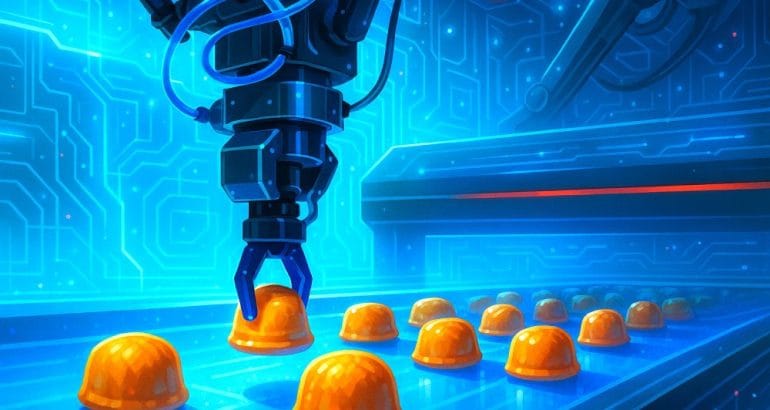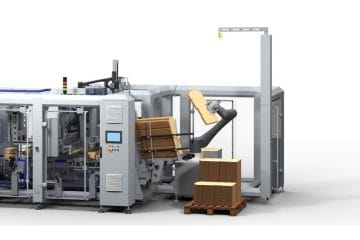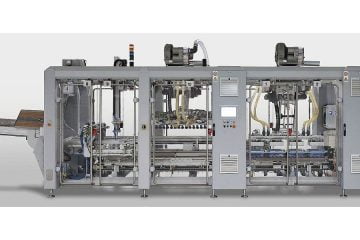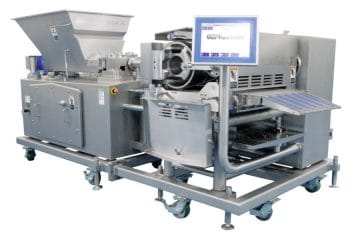by N. S.
Inspection is continuous, detailed, and aligned with the needs of modern packaging, towards zero defects. Data exchange via dedicated protocols increases system effectiveness: fewer rejects, faster changeovers, and full traceability. On washdown lines, versions with protective enclosures and components suitable for these conditions are available. Data management is ongoing: images are collected, information is updated, and algorithms are refined. This keeps quality stable even as formats, materials, and suppliers change.
The importance of the vision system
“An intelligent vision system with Artificial Intelligence (AI) allows the machine to be fed with products that arrive variably, without dedicated conveyors, complex mechanical guides, or rigid formats. The same infeed point handles multiple sizes, shapes, and orientations, reducing changeovers and downtime,” begins Cristian Sala, Sales Executive Manager at Cama. “With market evolution, traceability has also become central: the system identifies product, lot, and date, integrating into the packaging cycle according to the typical requirements of the food sector as well as the pharmaceutical, cosmetics, and medical sectors.
Another key element is in-line quality control: vision checks product and package dimensions and integrity, label legibility and correctness, as well as visual defects, from non-conforming color to dents or imperfect closures. AI makes these checks robust even with variable lighting, glossy materials, or deformable products, improving the overall effectiveness of the machines and moving the line closer to zero defects. To understand how best to apply vision and AI on the line, a real-case analysis is useful: volumes, format mix, space constraints, and traceability requirements define the optimal configuration and the return on investment.”
2D or 3D: the machine’s eye checks quality
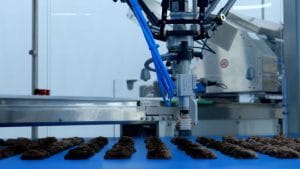
In packaging quality control, the “eye” matters: camera, optics, and lighting determine what the system sees and the reliability of inspection. Hardware selection must be calibrated to the use case, considering format, line speed, critical areas, expected quality level, and budget constraints. “Together with the customer, we define the right quality–need and quality–price balance, choosing the most suitable sensor for the product: flexible pouches, bags, sachets, and sticks may require different configurations with different resolutions and reflection management.
The vision system, combining 2D/3D cameras and Artificial Intelligence (AI), acts as the machine’s ‘eyes and brain.’ It reads codes and texts with Optical Character Recognition (OCR), checks labels, closures, and fill levels, flags defects in real time, and communicates with the PLC to achieve fewer rejects, faster changeovers, and more stable production.
The choice depends on the required control and the line environment. For planar measurements, reading texts, dates, and lots, and verifying label presence and position, two-dimensional (2D) vision is generally sufficient: fast integration, accuracy, and contained cost. On multi-variant or multi-flavor lines, 2D quickly identifies prints and codes and ensures the correct assortment in the carton or case. When volumetric measurements, height, depth, and orientation are needed, or when deformations, non-conforming fills, and raised defects occur, three-dimensional (3D) vision becomes the preferred choice: it reconstructs the real geometry and remains stable even with complex products or variable conditions. The result is greater inspection reliability, fewer errors, and continuity of the production rhythm.
Fortunately, technological evolution has brought ever faster and more sensitive sensors, dedicated optics, and stable lighting units that improve repeatability. Our engineering office works with specialized partners to validate the most efficient camera-optics-lighting combination, tailoring the application by sector and ensuring reliable control without unnecessary costs,” explains Cristian Sala.
In pursuit of total quality packaging
An intelligent vision system detects defects in real time, tracks every unit, and generates data on quality and efficiency. Integrated into the Manufacturing Execution System (MES). These data make it possible to move from detection to correction: volumes and rejects are analyzed, root causes are identified, recipes and settings are adjusted, and stoppages are reduced.
“A concrete example in a pet food application: data analysis showed that an incorrect mix of flavors had caused reject generation at machine infeed. By rebalancing the upstream process, rejects decreased and the product flow in the packaging process stabilized, increasing overall efficiency. Companies are particularly interested in quality and often keep these data confidential because they describe their operational effectiveness: reject rates, product quality, bottlenecks. When we collaborate on analyzing this information, we help the customer turn data into actions: targeted adjustments, more effective recipes, shorter changeover times, resulting in fewer stoppages and moving toward zero defects. If you wish to assess how vision data can improve quality and traceability, we can carry out a preliminary analysis and propose targeted actions that will improve plant performance.”
Data analysis: vision systems as an integral part of packaging
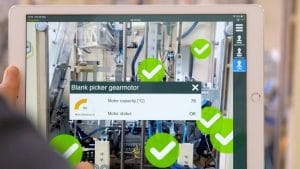
The vision system is an integral part of Cama machines: hardware, code, algorithms, and the Human Machine Interface (HMI) are designed around the application, based on the product and line speed, and validated on real samples. Upon delivery, the machine includes integrated quality control and a data flow ready for analysis.
Performance has grown significantly: defect detection reaches very high levels, over 99% depending on the case, thanks to more sensitive sensors and mature analysis models. Accuracy on dimensions, shape, and color is higher, and tolerances are tighter and customizable, so the range between conforming and non-conforming is defined with greater precision.
The effect is tangible on operations and the environment: fewer rejects and reworks, less material waste, and higher line efficiency. The result is a double benefit: controlled costs and a smaller environmental footprint.
Software is also evolving with Artificial Intelligence (AI) and Generative Artificial Intelligence (GenAI), which automate parts of the code. Developers can focus on functions, reliability, and usability, accelerating the release of performance and quality improvements.
Artificial Intelligence: a valuable aid that needs training
Artificial Intelligence (AI) is becoming a particularly useful tool. It can turn production data into concrete actions, suggest settings, prevent defects, make recipes more robust, and reduce configuration errors and commissioning times. During design, AI can assist with code writing and, based on the components selected, include or exclude incompatible parts. AI writes rules and programs, and it will do so increasingly well the better it is trained on the subject.
Generative Artificial Intelligence (GenAI) also requires targeted training in real contexts, with a packaging-specific technical glossary to speak the factory’s language. Every plant is unique, so GenAI must be trained with specialized knowledge of the specific process. The goal is a continuous loop, data, diagnosis, corrections, verification, with measurable benefits in quality and efficiency.
Real-time system adjustments toward zero defects
Sensor and vision data are analyzed very quickly in real time. Artificial Intelligence (AI) can propose micro-adjustments to line parameters, with direct effects on quality, stability, and scrap.
“Machine vision must make decisions very fast, just think of pick-and-place operations. Machines have to think and decide in real time which product to pick and at what angle to place it, rejecting out-of-spec items. The model will run at the edge (edge computing) to ensure low latency. The operator will validate the proposals via the Human Machine Interface (HMI), within preset safety limits. It’s not about overturning the machine’s behavior, but optimizing it continuously and adaptively,” continues Sala.
“Network updates will distribute digitally signed recipes and models. This approach will reduce scrap and rework, increase stability, and improve the overall effectiveness of the equipment. In pick-and-place robots, 2D/3D vision and algorithms will decide grip and orientation in milliseconds. In quality control, Generative AI (GenAI) will handle both regular shapes (biscuits) and irregular products (e.g., croissants) and will make character reading on labels easier. Today, the first steps are technically ready but still not widely adopted. Adoption will depend on data governance, clear roles between the operator and AI, and shared success metrics”
Software-centric and specialized: is this the future of packaging machines?

“We will see increasingly advanced software updates alongside mechanical upgrades to the machine. Over time, we will have software tailored to each application, from beverage packaging to medical products to dairy,” says Cristian Sala.
“We can get there by instructing machines for individual applications: start from a basic automatic machine that can be programmed and equipped with dedicated software for each use. The approach is an initial software-defined platform, meaning a machine where the hardware remains common while dedicated programs enable specific functions and controls. It’s the same concept already seen with robots for Automatic Carton Loading (ACL), which are taught to perform different operations. The advantage is greater flexibility, upgradability over time, and rapid adaptation to different formats and products.”
Machines are becoming software-centric: hardware remains the foundation, while software and Artificial Intelligence (AI) models adjust settings, logic, and controls to reduce defects. This evolution will bring clear benefits such as extending machine life.
With the same platform, different products can be packaged, biscuits, beverages, medical devices, by loading dedicated application packages: recipes, vision models, pick-and-place models, Optical Character Recognition (OCR), and label management.
Over time, vertical software by category will emerge, trained on real data, so the machine learns the operating context (beverage, food, medical). Updates will enable new functions with minimal mechanical intervention: advanced vision, more stable recipes, and automatic micro-adjustments to speed and production-flow synchronization. The benefit is tangible: fewer defects and scrap, higher process continuity, and rising quality and efficiency.

